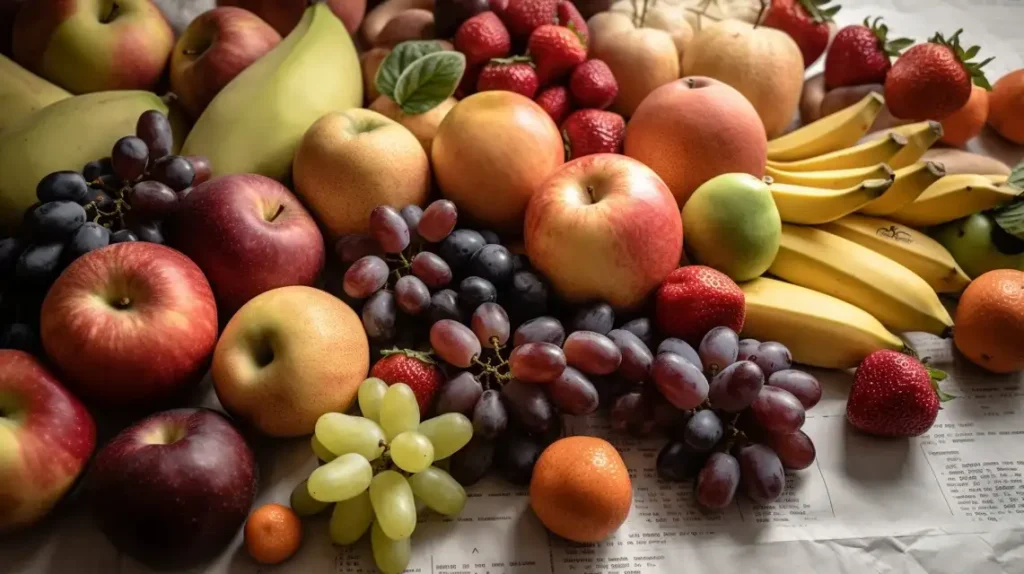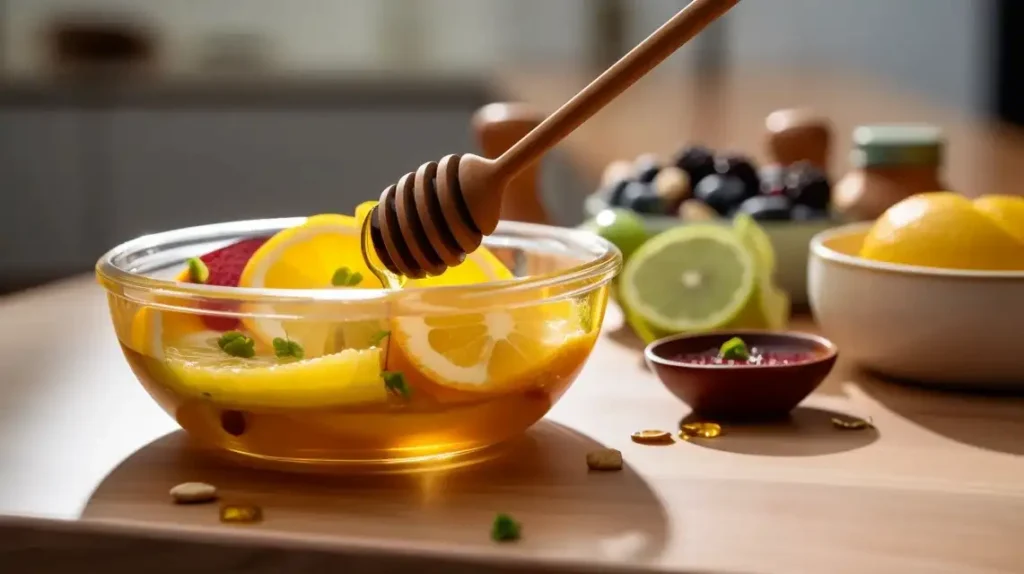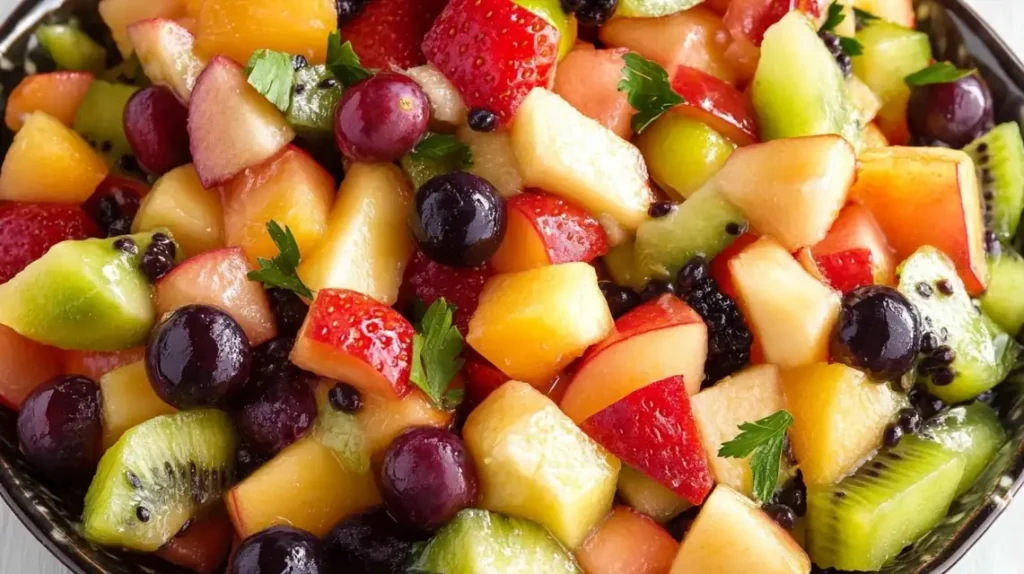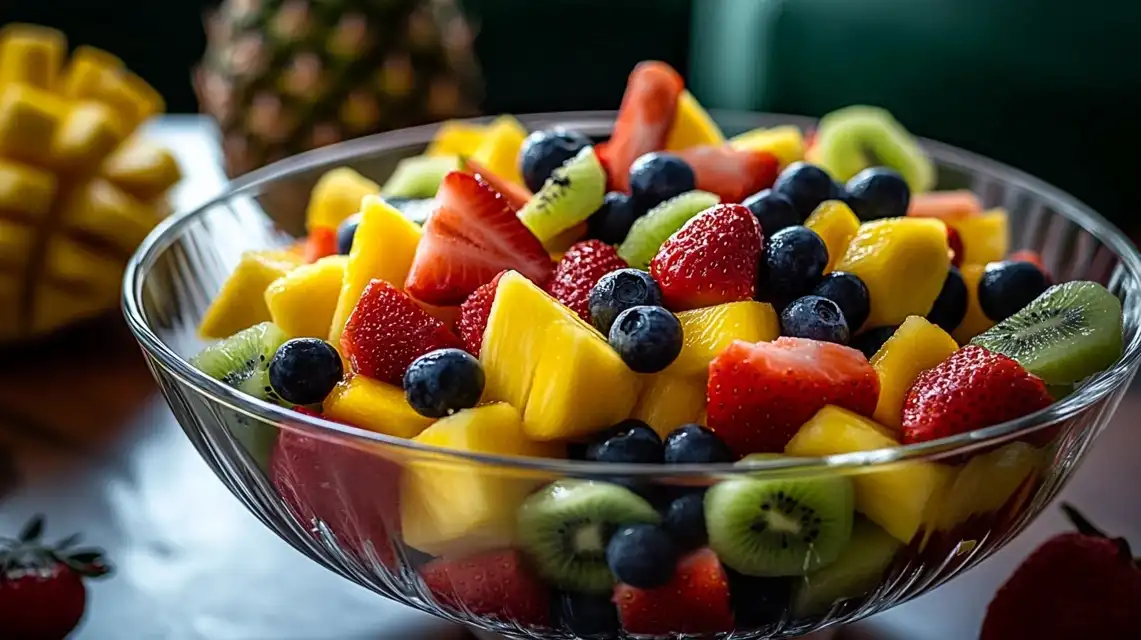Fruit Salad Recipe is the perfect way to add freshness, color, and natural sweetness to your day. Whether you’re making it for a summer picnic, a light dessert, or a nutritious breakfast, the right combination of fruits makes all the difference. A well-made fruit salad recipe bursts with juicy flavors, vibrant colors, and the perfect balance of textures, making every bite exciting and refreshing.
But what makes the perfect fruit salad? Choosing the right fruits, preparing them properly, and crafting a flavorful dressing are all key. In this guide, I’ll walk you through everything you need to know to make a fruit salad recipe that’s not only delicious but also fresh and visually stunning.
Introduction to Fruit Salads
The Appeal of a Well-Made Fruit Salad Recipe
Fruit salad is easy, versatile, and naturally sweet. It’s packed with nutrients and can be customized for any occasion.. Whether you prefer a tropical mix with mango and pineapple or a classic blend of berries and apples, the possibilities are endless.
One of the best things about fruit salads is their balance of flavors and textures. A good mix will have the right combination of sweetness, tartness, crunch, and juiciness. The key is selecting the right fruits and combining them thoughtfully so no single ingredient overpowers the dish.
“A great fruit salad is like a symphony—each fruit adds its own note, but together they create a masterpiece.”
Nutritional Benefits of Fresh Fruits
Aside from their great taste, fruit salads are packed with vitamins, minerals, and antioxidants. Different fruits offer different health benefits:
- Berries (strawberries, blueberries, raspberries) are rich in antioxidants that support heart health.
- Bananas provide potassium, which helps regulate blood pressure.
- Oranges and pineapples are loaded with vitamin C to boost the immune system.
- Apples offer fiber, keeping digestion on track.
Since fruit salads are naturally sweet, they’re a healthy alternative to processed desserts. Plus, the high water content of most fruits keeps you hydrated, making them a perfect snack during hot weather.
Selecting the Best Fruits for Your Salad

Seasonal Fruit Selection
Choosing fruits that are in season makes a big difference in taste and texture. Seasonal fruits are fresher, juicier, and more flavorful compared to those that have been stored for long periods. Here’s a quick guide to picking fruits by season:
| Season | Best Fruits for Fruit Salad |
|---|---|
| Spring | Strawberries, kiwis, pineapples, cherries |
| Summer | Mangoes, peaches, watermelon, blueberries |
| Fall | Apples, pears, grapes, pomegranates |
| Winter | Oranges, grapefruit, persimmons, bananas |
By selecting fruits that are naturally at their peak, you enhance the sweetness and juiciness of your salad without needing extra sweeteners.
Balancing Flavors and Textures
A great fruit salad recipe isn’t just about throwing random fruits together. The best ones have a mix of flavors and textures that complement each other. Here’s how to achieve that balance:
- Sweet fruits (grapes, mangoes, bananas) add natural sugar.
- Tart fruits (kiwis, oranges, pineapples) provide a tangy contrast.
- Crunchy fruits (apples, pears) add texture.
- Soft fruits (strawberries, melons) keep it juicy and refreshing.
By mixing these different fruit types, you create a salad that’s both visually appealing and satisfying to eat.
Tips for Choosing Ripe Fruits
The secret to a juicy fruit salad is using perfectly ripe fruits. Here are some tips to help you pick the best ones:
- Berries: Look for firm, plump ones with vibrant color. Avoid mushy or bruised berries.
- Bananas: A few brown spots mean they’re ripe and naturally sweeter.
- Mangoes & Peaches: Press gently—if they give slightly, they’re ready to eat.
- Apples & Pears: Choose ones that feel heavy for their size, as they’re usually juicier.
Avoid overly ripe fruits that are too soft, as they can turn mushy in the salad. On the other hand, unripe fruits won’t have the sweetness you need.
Preparing Fruits: Techniques and Tips
Washing and Cleaning Fruits Properly
Before cutting any fruit, it’s essential to wash them thoroughly. Even fruits with inedible peels (like melons and oranges) should be rinsed since bacteria from the skin can transfer to the flesh when sliced.
Best ways to wash fruits:
- Berries: Rinse under cold water just before use to prevent them from softening.
- Apples & Grapes: Soak in a mix of water and vinegar to remove pesticides.
- Melons & Citrus Fruits: Scrub the outer skin with a brush under running water.
Proper washing removes dirt and bacteria, keeping your fruit salad fresh and safe to eat.
Peeling, Coring, and Slicing Methods
Cutting fruits the right way helps maintain their shape and texture. Here are some simple techniques:
| Fruit | Best Cutting Method |
|---|---|
| Strawberries | Hull them using a straw or knife. |
| Apples & Pears | Core and slice thinly for even bites. |
| Pineapple | Cut off the skin, remove the core, and dice into chunks. |
| Mango | Slice off the cheeks, score the flesh, and scoop it out. |
Keeping fruit pieces similar in size makes the salad more enjoyable to eat.
Preventing Browning in Fruits
Certain fruits, like apples, bananas, and pears, turn brown quickly after cutting. To prevent this:
- Use citrus juice: Squeeze lemon, lime, or orange juice over sliced fruits.
- Soak in water: A quick soak in cold water slows oxidation.
- Refrigerate promptly: Keeping the salad chilled helps maintain freshness.
“A simple splash of lemon juice can keep your fruit salad looking bright and appetizing for hours!”
Crafting the Perfect Dressing
Simple Syrups and Natural Sweeteners

Sometimes, fruit salad needs a little extra sweetness. Instead of refined sugar, try these natural options:
- Honey or Maple Syrup: Drizzle lightly for added depth of flavor.
- Simple Syrup: Boil equal parts sugar and water, then cool before mixing.
- Agave Nectar: A great vegan-friendly option.
Adding a light syrup enhances the juiciness of the fruits without overpowering their natural flavors.
Citrus-Based Dressings for Extra Zing
A zesty citrus dressing enhances the juicy sweetness of the fruits while keeping them fresh and vibrant. Try this simple mix:
- ¼ cup orange juice
- 2 tbsp lemon or lime juice
- 1 tbsp honey or agave nectar
Whisk together and toss with your fruit salad for a refreshing boost.
Incorporating Herbs and Spices
Want to take your fruit salad to the next level? Add fresh herbs or warming spices:
- Mint adds a fresh, cooling touch.
- Basil pairs well with berries and citrus.
- Cinnamon enhances apple-based salads.
- Ginger adds a subtle kick.
With the right dressing, your fruit salad will go from good to absolutely irresistible!
Common Problems and Solutions
Even though making a fruit salad recipe seems simple, a few common mistakes can lead to a less-than-perfect dish. Nobody wants a soggy, bland, or mushy salad. Luckily, these issues are easy to fix with the right techniques.
Avoiding a Watery Fruit Salad Recipe
Nothing ruins a fruit salad recipe faster than excess liquid pooling at the bottom of the bowl. When certain fruits release too much juice, they make the salad watery and less flavorful.
How to Fix It:
- Choose firmer fruits: Strawberries, apples, and grapes hold their shape better than softer fruits like watermelon or peaches.
- Drain juicy fruits: If using watermelon or citrus segments, let them sit in a strainer for a few minutes before adding them to the salad.
- Toss with dressing right before serving: Citrus juice and sweeteners can draw out moisture. Add them just before serving to keep the salad fresh.
“A great fruit salad should be juicy—but not drowning in liquid. The right prep makes all the difference!”
Ensuring Uniform Fruit Sizes
One of the easiest ways to make a fruit salad recipe more enjoyable is to cut fruits into even-sized pieces. If some chunks are too big and others too small, the textures won’t mix well, and certain fruits might overpower others.
Best Practices for Even Sizing:
- Stick to bite-sized pieces: No one wants to struggle with a huge piece of melon while scooping.
- Match textures: If using soft fruits like bananas, cut them slightly larger to avoid them breaking apart.
- Use a melon baller for uniform shapes: This works well for cantaloupe, honeydew, and watermelon.
Creative Additions to Enhance Flavor
A fruit salad recipe can be simple and refreshing, but adding extra ingredients can take it from good to amazing. Consider these creative additions to boost flavor, texture, and overall appeal.
Nuts, Seeds, and Crunchy Elements
Adding something crunchy creates a satisfying contrast to the soft, juicy fruits. Some great options include:
- Toasted almonds or walnuts: A nutty crunch pairs well with sweet fruits.
- Pumpkin seeds or sunflower seeds: These add texture without overpowering the fruit flavors.
- Granola: A sprinkle of granola makes fruit salad feel like a dessert or breakfast dish.
A sprinkle of cinnamon or nutmeg enhances apples, pears, and bananas. If you love warm spices, check out our Apple Pie Cinnamon Rolls
Using Dried Fruits for Chewy Texture
Dried fruits provide natural sweetness and a chewy bite that complements fresh fruits. Some great choices are:
- Cranberries: Add a tart contrast to sweet fruits.
- Raisins or golden raisins: Naturally sweet and perfect with apples or pears.
- Chopped dates or figs: Provide a caramel-like flavor that pairs well with citrus.
Adding a Touch of Dairy or Plant-Based Alternatives
Creamy elements can make a fruit salad recipe richer and more satisfying. Whether you prefer dairy or plant-based options, these additions can work beautifully:
- Greek yogurt: Adds protein and a creamy texture.
- Coconut cream: A great dairy-free alternative with a hint of tropical flavor.
- Ricotta or mascarpone cheese: These pair well with honey-drizzled fruit salads.
Fruit salad pairs well with breakfast dishes. Serve it alongside our Sourdough French Toast Casserole for a balanced meal.
Fruit Salad Recipe: Presentation and Serving Ideas
A well-presented fruit salad recipe is just as impressive as its taste. Whether serving at a party or enjoying a simple family meal, presentation can elevate the dish.
Choosing the Right Serving Dish
The right serving dish makes the salad look as good as it tastes. Consider these options:
- Clear glass bowls: Showcase the colorful layers of fruit beautifully.
- Individual cups or mason jars: Perfect for portion control and grab-and-go servings.
- Hollowed-out pineapple or watermelon: A creative and fun way to serve fruit salad at summer parties.
Garnishing for Visual Appeal
A little garnish can make a fruit salad recipe look restaurant-worthy. Here are some simple ways to make your salad stand out:
- Mint leaves: Bright green leaves add freshness and contrast.
- Shredded coconut: Works especially well in tropical fruit salads.
- Edible flowers: Safe-to-eat blooms like pansies or nasturtiums add elegance.
“We eat with our eyes first—so why not make your fruit salad look as good as it tastes?”
Pairing Fruit Salad with Other Dishes
A fruit salad recipe works well on its own, but it can also complement other foods. Here are some great pairings:
- With breakfast: Serve alongside pancakes, waffles, or oatmeal.
- As a side dish: Pairs well with grilled chicken, fish, or even BBQ.
- With desserts: Goes great with ice cream, yogurt, or pound cake.
Fruit salad pairs well with breakfast dishes. Serve it alongside our Sourdough French Toast Casserole for a balanced meal.
Storing Leftovers Safely
Fruit salads are best enjoyed fresh, but proper storage can keep them tasting great for longer.
Refrigeration Tips
To keep fruit salad fresh, store it in an airtight container in the refrigerator. Some other tips include:
- Avoid over-mixing: Stirring too much can cause fruit to break down.
- Use a glass container: This helps retain freshness better than plastic.
- Consume within 2 days: While some fruits hold up well, softer ones like bananas may become mushy.
Reviving Leftover Fruit Salad
If your fruit salad loses its freshness, try these tricks:
- Add fresh citrus juice: A splash of orange or lemon juice can brighten flavors.
- Mix in crisp fruits: If the salad is too soft, toss in some fresh apples or grapes.
- Freeze for smoothies: Leftover fruit can be frozen and blended into a smoothie the next day.

Conclusion
A great fruit salad recipe comes down to fresh ingredients, the right balance of flavors, and proper preparation. To make sure your fruit salad turns out perfect:
- Choose ripe, seasonal fruits for maximum flavor.
- Cut fruits evenly to make the salad easier to eat.
- Use a citrus-based dressing to keep colors vibrant.
- Experiment with toppings like nuts, dried fruits, or yogurt for extra texture.
The beauty of a fruit salad recipe is that you can make it your own. Try different fruit combinations, adjust sweetness levels, and explore new add-ins. Whether you’re making a quick snack or a stunning party dish, fruit salad is a simple yet impressive way to enjoy fresh produce.
What’s your favorite fruit combination? Try this recipe and share your twist in the comments! And if you’ve got a creative twist on fruit salad, share it in the comments. I’d love to hear your ideas!
Frequently Asked Questions About Fruit Salad Recipes
1. What fruits should not be mixed in fruit salad?
Some fruits don’t mix well due to texture, acidity, or enzyme reactions. Avoid combining:
- Melons with other fruits – Watermelon, cantaloupe, and honeydew have high water content, which can make the salad watery.
- Bananas and apples without citrus – They brown quickly unless coated with lemon or lime juice.
- Kiwi and pineapple with dairy – Their enzymes can break down proteins, causing a bitter taste.
For the best fruit salad, stick to compatible textures and flavors, and always balance sweet, tart, and juicy fruits.
2. What makes a good fruit salad?
A great fruit salad has the right mix of freshness, balance, and texture. Here’s how to make it perfect:
- Use seasonal fruits – They’re juicier, sweeter, and more flavorful.
- Balance flavors – Combine sweet (mango, grapes), tart (kiwi, oranges), and neutral fruits (apples, melons).
- Cut evenly – Bite-sized pieces ensure a uniform texture in every spoonful.
- Prevent browning – Use citrus juice to keep apples, pears, and bananas fresh.
- Enhance with dressing – A light honey-lime dressing brings out the natural flavors.
A good fruit salad should be vibrant, juicy, and refreshing, not soggy or overly sweet.
3. How do professional chefs like Gordon Ramsay make fruit salad?
GProfessional chefs, including Gordon Ramsay, create elevated fruit salads by focusing on freshness, balance, and presentation. Their techniques typically include:
- Using seasonal fruits – Fresh mangoes, berries, and citrus for peak flavor.
- Adding a citrus element – Orange or lime zest enhances natural sweetness.
- Incorporating fresh herbs – Mint or basil adds a subtle, refreshing aroma.
- Drizzling with natural sweeteners – A touch of honey or agave syrup balances flavors.
- Letting flavors blend – Chilling the salad for 15 minutes allows the dressing to soak in.
For a gourmet touch, chefs often pair fruit salad with lightly whipped yogurt, toasted nuts, or a splash of balsamic glaze. These simple yet effective upgrades turn an ordinary fruit salad into a restaurant-quality dish.
4. What are the ingredients in fruit salad with honey and lime dressing?
A honey-lime fruit salad dressing enhances the natural flavors of fresh fruit. Here’s what you need:
For the Fruit Salad:
- 2 cups strawberries, sliced
- 1 cup blueberries
- 1 cup grapes, halved
- 2 kiwis, peeled and chopped
- 1 cup pineapple, diced
- 1 orange, segmented
For the Honey-Lime Dressing:
- ¼ cup honey – Adds natural sweetness
- 2 tbsp fresh lime juice – Brightens flavors and prevents browning
- 1 tsp lime zest – Enhances citrus aroma
- ½ tsp vanilla extract (optional) – Adds depth to the flavor
Instructions:
- Whisk together honey, lime juice, zest, and vanilla.
- Pour over the fruit and gently toss to coat.
- Let sit for 10-15 minutes before serving to allow flavors to blend.
This dressing keeps the fruit salad fresh, juicy, and naturally sweet without overpowering its flavors.
Table of contents

Fruit Salad Recipe: How to Make It Juicy and Delicious
Equipment
- Cutting board For chopping fruits evenly.
- Sharp knife A chef’s knife or paring knife for peeling and slicing.
- Mixing bowl A large bowl to combine the fruit and dressing.
- Citrus juicer For extracting fresh lime juice.
Ingredients
- 🟢 For the Fruit Salad:
- 2 cups strawberries sliced
- 1 cup blueberries
- 1 cup grapes halved
- 2 kiwis peeled and diced
- 1 cup pineapple chopped
- 1 orange segmented
- 🟡 For the Honey-Lime Dressing:
- ¼ cup honey or maple syrup for vegan
- 2 tbsp fresh lime juice
- 1 tsp lime zest
- ½ tsp vanilla extract optional
Instructions
- 1️⃣ Prepare the fruits – Wash and chop all fruit into bite-sized pieces. Place in a large mixing bowl.
- 2️⃣ Make the dressing – In a small bowl, whisk together honey, lime juice, zest, and vanilla until well combined.
- 3️⃣ Combine – Pour the dressing over the fruit and gently toss to coat.
- 4️⃣ Chill & Serve – Let the salad sit for 10-15 minutes to enhance flavors. Serve immediately or refrigerate for up to 24 hours.
Notes
You can substitute any seasonal fruits based on availability.
